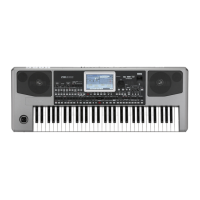
Do you have a question about the Korg PA900 and is the answer not in the manual?
| Brand | Korg |
|---|---|
| Model | PA900 |
| Category | Musical Instrument |
| Language | English |
FCC, CE, Consumer notices, and Disposal guidelines.
Specific handling instructions for perchlorate material in California.
List of included accessories and items with the Pa900.
Information on the manual's content and resources.
Information on contacting Korg dealers and distributors.
Covers data backup, factory restore, and OS loading.
Detailed explanation of the Pa900's front panel layout and controls.
Description of the Pa900's rear panel connections and ports.
Covers physical, sound, style, mic, and other instrument features.
Instructions for backing up instrument data to prevent loss.
Procedure to restore the instrument to its factory default settings.
Guidance on updating the instrument's operating system.
Information on integrated speakers and headphone connection.
Explanation of the joystick's function for pitch bend and modulation.
Master Volume, Balance, and Assignable Knob functions.
Overview of operating modes and Global/Media buttons.
How to select and use Styles and associated settings.
STS mode, Memory, Bass Inversion, Manual Bass, and Chord Sequencer controls.
Buttons for recording, track selection, and editing.
How to play pads and use player controls.
Using Style Elements like Intros, Variations, Fills, Breaks, and Endings.
Style controls for tempo management and fade in/out.
Start/Stop buttons and SongBook database usage.
Ensemble function, display brightness, and data navigation.
Accessing menu, lyrics, score, and marker features.
Selecting sounds and configuring keyboard split.
Managing tempo and metronome settings.
Keyboard split and transpose functionalities.
Selecting performances and changing associated styles.
Microphone setup, USB connection, and device management.
Functionality for putting the instrument into standby mode.
Attaching the music stand and connecting to video output.
Connecting to computers and external MIDI devices.
Connecting pedals and audio output interfaces.
Connecting line-level audio sources and external audio.
Connecting the instrument to the power supply.
Connecting power and turning the instrument on/off standby.
Using volume controls and connecting headphones.
Details on loudspeakers, audio outputs, and MIDI connections.
Connecting pedals and attaching the music stand.
Definitions of Sound, Style, Drums, Percussion, Accompaniment, Variation, Fill, Intro, Pad, Keyboard Tracks.
Definitions of STS, Ensemble, Performance, Sequencer, Player.
Explanation of LOGO decoder terms like GM, RX, DNC, TouchView, TC-Helicon.
Overview of the touch-panel LCD graphical interface.
Menus, sections, pages, overlapping windows, dialog boxes, page menus.
Pop-up menus, checkboxes, numeric fields, editable names, lists, virtual sliders.
Understanding modes, virtual knobs, drawbars, icons, and selection indicators.
Using shortcuts and understanding parameter availability.
Steps to activate the simplified Easy Mode interface.
Style name, tempo, performance/preset, split point, and mic talk controls.
Song name, tempo, performance/preset, split point, and mic talk controls.
How to start, choose, and stop the built-in demo songs.
Steps to select and play a sound on the keyboard.
How to layer multiple sounds on the keyboard.
How to split the keyboard and play different sounds with each hand.
Procedure to set a custom split point on the keyboard.
Adjusting the octave for upper keyboard tracks.
How to choose and load a saved Performance.
Steps to save current instrument settings as a Performance.
How to recall and save default startup settings.
Selecting presets for the Drawbars sound emulation.
Adjusting drawbar settings and saving them.
Steps to choose and play a musical Style.
Choosing a style, setting scan modes, synchro-start, and playing.
Changing tempo, using Tempo Lock.
Using Style Elements like Intros, Variations, Fills, Breaks, and Endings.
Using Single Touch Settings for instant sound and effect recall.
Assigning and playing sounds or patterns with the Pads.
Balancing volumes between keyboard and style tracks.
Adjusting individual track volumes within a Style.
Muting or unmuting individual Style tracks during playback.
Using the Ensemble function to add automatic vocal harmonies.
Recording and playing back chord sequences.
Steps to choose and load a song for playback.
How to start, control, and stop song playback.
Adjusting the volume of individual song tracks.
Muting or unmuting individual song tracks.
Isolating tracks and removing melody/vocals from songs.
Assigning functions to switches for song control.
Selecting an alternative melody track for songs.
Playing and mixing two songs simultaneously using the X-Fader.
Browsing and selecting entries from the SongBook database.
Switching the SongBook display between artist and genre columns.
Changing the order and filtering SongBook entries.
Procedures for adding and modifying SongBook entries.
Steps to create personalized lists of SongBook entries.
How to select and play songs from a custom list.
Connecting a dynamic microphone to the instrument's audio input.
Adjusting equalization, compression, and gate for vocal tone.
Selecting and applying voice processor presets.
Using Styles and Songs to generate automatic vocal harmonies.
Adjusting levels for voice, effects, styles, and songs.
Using the Talk function to mute music and amplify voice.
Selecting Styles and Sounds before recording a Song.
Entering the Quick Record mode for creating Songs.
Setting record parameters and the recording process.
Recording additional tracks or replacing recorded tracks.
Procedures for saving recorded Songs to storage.
Steps to record a performance as an MP3 file.
General procedure for searching files and resources.
Important notes and wildcard usage for search functionality.
Safety precautions and step-by-step instructions for battery replacement.
Safety precautions and step-by-step instructions for microSD card installation.
Instructions for accessing and removing the microSD card.